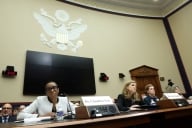You have /5 articles left.
Sign up for a free account or log in.
WASHINGTON -- What makes a good cup of tea? Is it the quality of leaf, or milk and sugar? How about the steeping time? Or could it be the way the drink makes you feel once it’s finished?
Actually, it’s all of the above. And if the combination doesn’t work, it might end up tasting like "dishwater."
This is the analogy that set the stage for a conference on revitalizing medical education that the American Medical Association and the Association of American Medical Colleges opened here Monday.
As medical educators ponder how to respond to an evolving health care system and technological landscape, new ideas like three-year M.D. programs and personalized education have gained traction and even taken hold at some colleges. But there is still much conversation over how -- and how quickly -- to move forward.
Panelist George Thibault, president of the Josiah Macy, Jr. Foundation, says it's time for the industry to take action. “The pace has been inadequate for the challenge and the pace needs to pick up,” he said.
The conference, “New Horizons in Medical Education: A Second Century of Achievement," coincides with the centennial of the Flexner Report, the 1910 examination of all 155 medical schools in North America (there are 150 today) that provided a base for the continent’s medical education model. The conference convened medical educators, practitioners, graduate students and residents at a Washington hotel, where they are spending three days discussing the state of medical education today and what the medical education of tomorrow should look like.
Brian Hodges, director of the Wilson Centre for Research in Education at the University of Toronto, opened Tuesday’s panel discussions with a speech critiquing today’s “Tea-Bag Steeping” model of medical education – essentially, the student is the tea bag and the water is the educator; submerge the student for four years and pull out a doctor. But Hodges also has an eye on the future.
The themes of Hodges’s speech echoed the sentiments of a June report released by the Carnegie Foundation for the Advancement of Teaching -- which commissioned the Flexner report -- recommending a shift in medical education away from rigid, hyper time- and content-sensitive programs, toward more flexible ones focused on student competence.
Both the tea-bag steeping model and a more modern, flexible model have useful features, said another panelist, Emmanuel G. Cassimatis, president and C.E.O. of the Educational Commission for Foreign Medical Graduates. The important thing is to consider not only the time put into education, but also the quality of it.
Although Hodges prefers the term “outcome-based,” he does advocate the competence-based model that would focus more on individualization and flexibility. This could include variations in the time to degree or residencies, more efficient and individualized training periods, re-envisioned coaching models, and skill specialization with attention to technology.
Hodges calls these new educators “i-Docs.” They will be brave enough, he said, to look past the tradition, job security, predictability, lack of accountability and overly full curriculums that characterize the tea-bag model, and pioneer the outcome-based model that measures student competence throughout the education process with tests and standards, rather than having students soak in the same information and hoping that they are fully competent by the end.
As Thibault put it, the "i-Docs" will spur the industry to change, assess and change again.
Future programs should be based on five focuses, Thibault said: social responsibility, which he describes as “measuring ourselves at least in part by outside measures and not just inside measures”; integration of science and medicine; continuity, to allow for better evaluation and assessment (“one of our weakest points is assessment,” Hodges says); interprofession education (education is “a team sport,” Thibault said); and education for the needs of specific populations (such as the elderly), which requires differentiation.
The social responsibility component, which Hodges discussed as well, would call for medical schools to examine their admissions standards and institutional message to see why students aren’t taking jobs needed in today’s society.
Thibault is aware that the transformation, which is “not rejecting the Flexnarian principles, but building on them,” won’t be easy. It will take time, skill and faculty development and investment. Then again, the medical community is about due for a new revolution.
“We’ve been given a vision here,” he said. “We can do it wrong or we can do it right, and I think we know what we want the outcome to be.”








